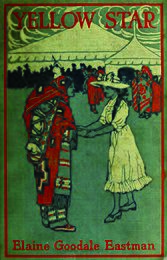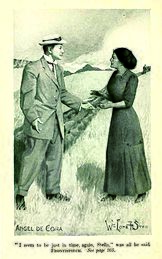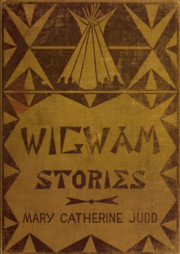Angel De Cora facts for kids
Quick facts for kids
Angel De Cora
|
|
|---|---|

Angel De Cora
|
|
| Born |
Hinook-Mahiwi-Kalinaka
May 3, 1871 |
| Died | February 6, 1919 (aged 47) |
| Nationality | Ho-Chunk |
| Known for | Painting & Illustration |
| Movement | Tonalism |
Angel De Cora Dietz (1871–1919) was a Winnebago painter and illustrator. She also worked as a Native American rights advocate and teacher. She taught at the Carlisle Indian School. Angel De Cora was a well-known Native American artist before World War I.
Contents
About Angel De Cora's Early Life
Angel De Cora was also known by her Ho-Chunk name, Hinook-Mahiwi-Kalinaka. This means "Fleecy Cloud Floating in Place." She was born in Nebraska on May 3, 1871. Her father, David Tall Decora, was a Winnebago man. He was the son of a hereditary chief. Angel was part of the Thunderbird clan.
When she was young, Angel was taken from her home. She was sent to a school called the Hampton Agricultural and Industrial School in Hampton, Virginia. She later said that a white man asked her if she wanted to ride a "steam car." She went with six other children. When the ride ended, she was in Hampton. She returned home three years later. Her mother told her she had cried for months. Angel's father and other family members had passed away. The old way of life for her people was gone.
Angel was the granddaughter of a Winnebago chief. This gave her an important position. In many Native American cultures, women held power and shared cultural knowledge. Angel's mother was partly French. Still, Angel was expected to follow her grandmothers. She was meant to pass on Winnebago traditions.
Angel De Cora's Education and Mentors
Angel De Cora was sent to the Hampton Normal and Agricultural Institute. The U.S. government wanted to train Native American girls. They hoped these women would become good housewives. This was meant to help them fit into mainstream American culture.
De Cora studied at a local school in Hampton. She also worked for a family there. Later, she attended the Burnham Classical School for Girls. She then studied art at Smith College. She focused on illustration at Drexel Institute, now Drexel University.
De Cora was one of the few students chosen for Howard Pyle’s summer art program. Pyle was a famous illustrator. He praised De Cora, calling her a "genius." Pyle knew that as a Native American woman, she would face challenges. Still, he believed in her talent. He helped her connect with magazines. He also encouraged her to write and illustrate her own stories. These stories, "The Sick Child" and "Gray Wolf’s Daughter," were published in Harper's Monthly in 1899.
In 1898, De Cora painted "Lafayette's Headquarters." This was one of her few works not featuring Native American subjects. She used a style similar to Impressionism. This showed Pyle's influence. Pyle and De Cora had a typical teacher-student relationship. However, they sometimes disagreed. Pyle often ignored how Native American clothing should look. He was very careful about historical accuracy for white clothing. De Cora also did not want to paint exactly like Pyle. She told him she was an American Indian. She wanted to paint in her own way.
After leaving Philadelphia, De Cora went to Boston. She studied life drawing at the Cowles Art School. Her teacher, Joseph DeCamp, recommended her to the Museum of Fine Arts. She studied there for two years. Her teachers were Frank Weston Benson and Edmund C. Tarbell. They were known for their outdoor figure paintings and use of light. These artists greatly influenced De Cora's later work.
Angel De Cora's Personal Life
De Cora married William Henry "Lone Star" Dietz. He said he was part Dakota and part German. His background is not fully clear. Dietz also taught at the Carlisle Indian School. They met at the St. Louis World's Fair in 1904. Besides art, Dietz was a famous football player. He became head coach of Washington State in 1915. He was later the first head coach of the Washington Redskins.
Angel De Cora's Art Style
De Cora's art combined Western art techniques with traditional Native American styles. Her figures often showed strong gestures. This is common in Native American pictographs. Her illustrations often went with text. This helped white Americans understand a traditional Native American art form.
Much of her work showed Native American life from a woman's point of view. This was new to many white Americans at the time. She also showed Native Americans as a changing people. She blended Native American and Euro-American elements in her art. This showed how cultures were mixing.
Angel De Cora's Artwork
Early in her career, De Cora developed a tonalist style. This was influenced by her teacher, Dwight William Tryon. Tonalism focuses on landscapes. It uses soft colors to create a misty or foggy feeling. In her tonalist paintings, De Cora used firelight. This brought back warm memories of her childhood on the Nebraska plains. She painted an oil painting for an Indian school exhibit. It was for the Pan-American Exposition in Buffalo, New York. This painting showed her skill and deep feelings.
When she worked with Howard Pyle, her style included more illustration. Pyle encouraged her to visit the Fort Berthold Reservation in North Dakota. He wanted her to reconnect with Native customs.
De Cora designed the title pages for The Indians' Book by Natalie Curtis. This book, published in 1907, collected Native American songs, stories, and art.
De Cora had a studio in New York City. Later in her career, she and her husband taught art. They taught at the Carlisle Indian Industrial School in Carlisle, Pennsylvania.
Sadly, not many of De Cora's original paintings still exist. However, she illustrated her own stories in Harper's Magazine. She also illustrated books. The 1911 book Yellow Star: A Story of East West has illustrations by De Cora and her husband. Her illustrations were special for her time. She showed Native Americans wearing modern clothing.
Some people today do not include De Cora among important Native American artists. They think her art looks "too Western." However, in her time, people called Angel "the first real Indian artist."
Group Exhibitions
- 2019: Hearts of Our People: Native Women Artists, Minneapolis Institute of Art, Minneapolis, MN
Angel De Cora's Death
Angel De Cora became ill with influenza and pneumonia. She was staying at a friend's home in Northampton. She passed away at the Cooley Dickinson Hospital on February 6, 1919. She was 47 years old. She was buried in her family's plot. She did not have a headstone. At that time, only blood relatives could have one.
Gallery





